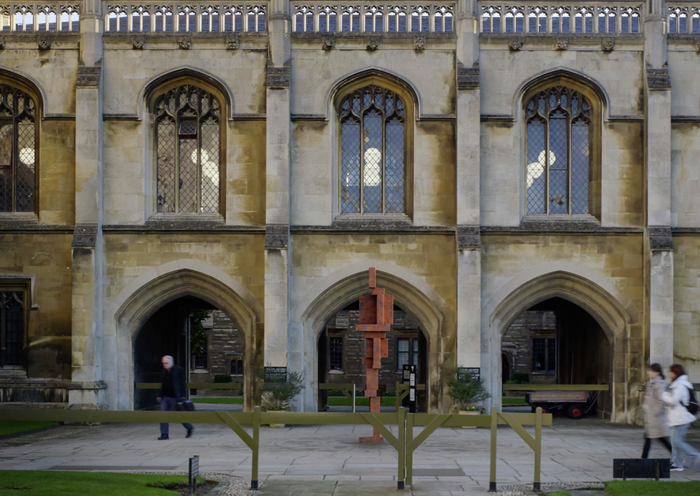Gavin Turk: ‘you’re able to introduce people to a different way of looking’
Turk’s latest exhibition ‘In Search of Ariadne’ at the Heong Gallery in Downing College details his artistic journey in the creation of the statue

When rushing to and from Cambridge station, I wonder how many of you have ever stopped and noticed the statue that sits outside. If the piece doesn’t immediately spring to mind, then imagine a wrapped-up lump tied in string (which my friend so helpfully described as a big shoe) and it might just jog your memory. The sculpture, called Ariadne Wrapped, is meant to depict a reclining Ariadne – the woman from Greek mythology who helped Theseus escape the labyrinth. Personally, I’d always assumed the covered sculpture was damaged or waiting to be restored. But, in fact, this wrapping was part of the sculptor Gavin Turk’s original intention.
Turk explained that he decided Ariadne was his muse by researching how her name was attached to this “male representation” of an “archetypal reclining figure.” But that didn’t answer my more probing question: why wrap her? He revealed that his inspiration for wrapping first stemmed from a show he did in 1996 at the South London Gallery. He decided to wrap all the works up for the opening night and then not actually open them until the day after as a “kind of performance art.”
You’re able to introduce people to a different way of looking
Turk's latest exhibition ‘In Search of Ariadne’ at the Heong Gallery in Downing College details his artistic journey in the creation of the statue. Much of this fascinating exhibition consists of wrapped waste. Products, such as old drainage pipes cast in bronze, are tied up in fabric so only a vague outline is left visible— or so the placard says. The viewer will never know for certain what actually lies beneath the covers. When I asked if he ever found the process of covering up his work frustrating he responded with a simple no. He explained that “I really like the investment you might make interpreting a rough shape— in the way that you might look at a cloud and say it’s an elephant.” Going further Turk said he liked the idea “that there’s a freedom and movement of ideas and perceptions in the world. When you slightly destabilise those perceptions, you’re able to question paradigms and ideologies, and introduce people to a different way of looking.”

Yet, I found the concealed paintings to be the most frustrating— in the best possible way. I'm still longing to discover what's hidden beneath the material. Titles like ‘Portrait of the Sailor Gentleman Jim’ invite an image that I’ll never be able to see for myself. Turk says “I think there is another side to making art which involves something of an illusion. If we take something from the real world and place it into an art context we make a picture of that thing.” He insists that it's “part of the human condition to want things to take up a certain order and to want things to be a certain kind of way. Disappointment is important as well and the fact that it’s always questionable.”
With this idea of questioning, he recounts an anecdote of when he visited the sculpture at the station and a lady asked him “what’s it going to be?” To her disappointment, he explained, “oh, this is it.” Looking back, he expresses regret at having ruined it because the future of the exhibition is “still full of potential.”
For many, I can understand why going to an exhibition of wrapped-up artwork doesn’t hold any particular interest. Of course, not every piece of work in the exhibit is wrapped, revealing Turk’s more traditional ‘artistic talent’ as well. From uncovered sculptures to eye-catching paintings, there is more to stimulate the eye than cloth and string. But with this more abstract work, comes the inevitable ‘I could’ve done that myself’ mentality that so many have when it comes to modern art. When I bring up this debate, Turk responded by claiming he's "a great fan of skill and craft. But sometimes when I’m skilling and crafting my own artwork I don’t necessarily see that as integral to the artwork.” He suggests that these mentalities “are just tools the artist can use to force people into questioning their set of values." He adds, "I’m also a great fan of the idea that everybody’s an artist, but I think lots of people won’t acknowledge that fact.”
However much I enjoyed the questions the exhibition posed and the experience of seeing the thought process behind the mysterious station statue, I understand that it may not be for everyone. Turk says that “contemporary art lives in this state of flux” that constantly questions“is this art?”. For Turk, for a piece to ask “is it art?” should be the qualifying definition of art in the first place.
 News / Clare Hall spent over £500k opposing busway 24 December 2025
News / Clare Hall spent over £500k opposing busway 24 December 2025 Comment / The ‘class’ of Cambridge24 December 2025
Comment / The ‘class’ of Cambridge24 December 2025 News / Caius mourns its tree-mendous loss23 December 2025
News / Caius mourns its tree-mendous loss23 December 2025 Comment / Yes, I’m brown – but I have more important things to say22 December 2025
Comment / Yes, I’m brown – but I have more important things to say22 December 2025 News / Girton JCR publishes open letter expressing solidarity with Palestine25 December 2025
News / Girton JCR publishes open letter expressing solidarity with Palestine25 December 2025










